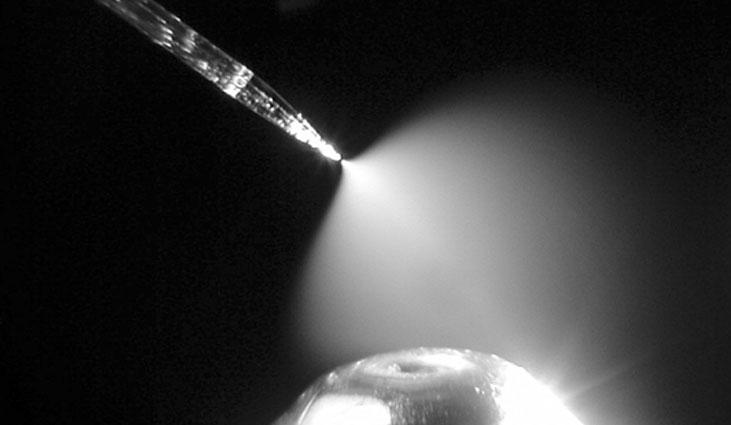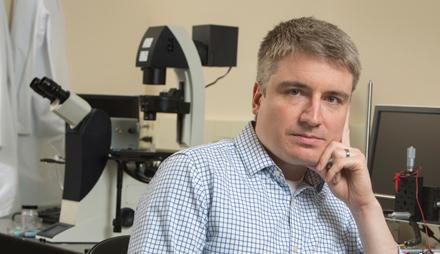 It’s hard to believe that we’ve already reached any sort of crossroads where 3D printing could already need redefining, but if you think about it, makers and scientists have been redefining the technology since square one to meet their own needs for innovation and production, and especially since digital design and 3D printing truly hit the mainstream.
It’s hard to believe that we’ve already reached any sort of crossroads where 3D printing could already need redefining, but if you think about it, makers and scientists have been redefining the technology since square one to meet their own needs for innovation and production, and especially since digital design and 3D printing truly hit the mainstream.
The industry, and technology, are in a constant—and spectacularly impressive—state of evolution. That is mainly in thanks to the brilliant minds of our time, and scientists like Paul Chiarot, a Binghamton University engineer whose research attracted a lot of attention; in fact, so much that he has received a five-year grant for $500,000 to continue his research with 3D printing and electronics.
With an eye on transforming manufacturing even further, Chiarot is examining the use of 3D printing on a finer scale than usual, which may offer further change in terms of how we make energy, offer healthcare, and even in dealing with security. The grant, funded by the National Science Foundation, centers around, not surprisingly, the further elimination of subtractive processes, focusing on printing electronics with a technique he refers to as electrospraying.
“The normal way we make things is we put material everywhere and then etch away what we don’t want,” Chiarot says. “You might end up etching away 90 or even 95 percent of the material. If you’re printing, you can just put the material where you want it to be.”
Chiarot’s electrospraying technique involves taking minute particles and putting them into a solvent which is then applied to a desire surface where electronics are created. A big part of this research and development seems to be in understanding the complexities of how this method could be applied, but presenting it in a simple way overall once they have harnessed what the full potential of electrospraying actually is.
“We want to understand this principle fundamentally,” Chiarot says, “and then, using that knowledge, we want to develop a manufacturing technique that can lead to new jobs.”
They are beginning with creating a strong foundation in working to manipulate very small structures and their composition.
“What we’re trying to do is to control at the smallest length scales what the structure of an individual layer looks like,” he says. “Right now there’s not a lot of control for that. But if you want to be able to get really nice functionality out of a 3D printed part, you want to be able to control what we call structure at the smallest possible length scales.”
Working in this extremely organized and fastidious fashion means that they will establish a new control over fabrication that will enable engineers to design and then manufacture 3D printing parts that encompass a specific range of properties in terms of:
- Optical
- Mechanical
- Electrical
- Thermal
He foresees working with magnetic materials, metals that can be used in solar projects, as well as materials like glass. They will, as is the growing trend today in 3D printing, also work with metals like graphene and carbon bases—all centered around the thermal properties and the building of new, unique, and improved electronics.
Chiarot sees the fundamental key in making a difference being that of greater study and resulting organization.
“If you imagine these particles were billiard balls that we just threw together — which is the way we do it now — and you wanted to pass electric current through that, if it’s randomly packed, it won’t do a great job of it,” Chiarot says. “But if we do it the way you line up billiard balls — in an orderly fashion — that should help us get better conductivity, a more efficient device or maybe one that requires less material.”’
With his technique, it’s a bit more complex than just applying a solvent as a high-voltage power supply and pump are a large part of the equation, delivering material to what would be the extruder—a nozzle which is similar in appearance to a syringe. The particles are electrically charged in the solvent and a very important part of the research and organization is that Chiarot sees a way to manipulate them with ‘secondary electric fields’ as they are moving. He foresees numerous nozzles side by side working together to perform a larger volume of production.
 Further ambitions are to translate his technique onto a variety of objects aside from the flat plastic and glass substrates he normally works with. With this type of extrusion, he foresees it being used for affordable, small-batch production—and perhaps even in remote locations like space. Chiarot sees the process translating well to other areas because electrospray can be applied in areas that aren’t completely sterile, and it works at room temperature. This process may very well play a role in manufacturing as it makes a resurgence in the US.
Further ambitions are to translate his technique onto a variety of objects aside from the flat plastic and glass substrates he normally works with. With this type of extrusion, he foresees it being used for affordable, small-batch production—and perhaps even in remote locations like space. Chiarot sees the process translating well to other areas because electrospray can be applied in areas that aren’t completely sterile, and it works at room temperature. This process may very well play a role in manufacturing as it makes a resurgence in the US.
“We need things, both small and large, not just cell phones, but jet engines and replacement parts, too. Manufacturing positions will come back, but it won’t be an assembly line.”
Chiarot, also right in line with the thinking of many others, believes encouraging students is very important in the process as well, in helping them to gain the toolsets they will need upon graduation, as well as providing the much-needed workforce for manufacturers—a need that is going to continue to grow. He works with doctoral and undergraduate students in the summers at the University of Toronto instructing in their STEM curriculum.
As 3D printing and additive manufacturing continue on their path to transforming so many industries, Chiarot sees the value in preparing his students—especially with a focus on open-source technology and all the power lying therein that the younger generations will most likely harness beyond our imaginations at this point. Discuss this new technology in the 3D Printing & Electrospraying forum over at 3DPB.com.
[Source: Discover-e / Electrospray Image: New Objective]Subscribe to Our Email Newsletter
Stay up-to-date on all the latest news from the 3D printing industry and receive information and offers from third party vendors.
You May Also Like
3D Printing News Briefs, April 13, 2024: Robotics, Orthotics, & Hypersonics
In 3D Printing News Briefs today, we’re focusing first on robotics, as Carnegie Mellon University’s new Robotics Innovation Center will house several community outreach programs, and Ugogo3D is now working...
Rail Giant Alstom Saves $15M with 3D Printing Automation Software 3D Spark
3D Spark has entered into a three-year deal with the rail giant Alstom. Alstom, a transport behemoth with annual revenues of $16 billion, specializes in the manufacture of trains, trams,...
Meltio Expands Global Reach with New Partnerships in the Americas and Europe
Spanish 3D printing manufacturer Meltio has expanded its sales network across the globe. With the addition of three new partners in the United States, Brazil, Argentina, and Italy, Meltio aims...
3D Printing Webinar and Event Roundup: April 7, 2024
Webinars and events in the 3D printing industry are picking back up this week! Sea-Air-Space is coming to Maryland, and SAE International is sponsoring a 3D Systems webinar about 3D...
































